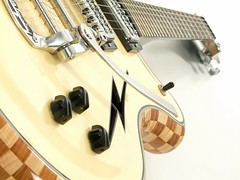Guitar Luthier and Laser Science Make Sweet Music
 If Dr. Evil wanted a rockin’ axe he would no doubt turn to Dagmar Custom Guitars to build it. Why? Because a Dagmar comes with frickin’ laser beams—that’s why.
If Dr. Evil wanted a rockin’ axe he would no doubt turn to Dagmar Custom Guitars to build it. Why? Because a Dagmar comes with frickin’ laser beams—that’s why.
Ontario luthier Pete Swanson launched his custom-built guitar business only a couple of years ago and yet he’s causing a stir in the guitar world with his beautifully rendered masterpieces. Inspired by Roman architecture, a Dagmar is a hybrid of traditional luthier artistry and state-of-the-art technique that integrates the strength of an arch’s keystone into the body of a one-of-a-kind musical instrument.
Each guitar is hand built, utilizing a unique manufacturing process that eschews steam or forms for math where the instruments body is made up of hundreds of precision cut segments that are glued together. Swanson applies a layer of carbon fiber to the interior of the frame and then machines the exterior surface to be mere millimetres of thickness. The result is a thin yet super strong harmonically resonant sound chamber.
Unlike a solid-body electric guitar, Dagmar’s standard (non laser) setup deploys piezoelectric pickups to register the instrument’s sound. Piezoelectric pickups register the vibration of the guitar’s soundboard (the face of the guitar) rather than the vibration of the string. The result is a richer tone than a standard electric pickup. In 2009, Swanson was invited to participate in The Montreal Guitar Show – a world class event for both exhibiting luthiers and guitar enthusiast.
“I feel honored to have received the invite to debut at this prestigious show,” said Swanson. “The venue is a wonderland filled with the highest caliber forms of the lutherie art where people are encouraged to become interactive with the builders and to test out their wares.”
Dagmar’s unique manufacturing process also caught the ear of Dr. Hans-Peter Loock, Associate Professor of Chemistry at Queen’s University. Loock and his team were researching the benefits of using fiber-optic gratings as chemical sensors when he heard about Dagmar Custom Guitars.
“Fiber optic gratings are used in monitoring of vibrations of, say, bridges, buildings, airplane wings, blades of wind turbines, etc.,” said Loock. “Eventually we put ‘acoustic detection’ and ‘vibration monitoring’ together and wondered whether they can act as pickups for musical instruments.” Eureka!
Loock’s photonic pickup works by “tuning a small laser to the maximum of the reflection spectrum and monitoring the intensity of the reflected light as the grating period stretches and compresses with the vibration of the sound board,” said Dr. Loock. “The fiber-optic pickup has a nearly flat frequency response from infrasound (< 10Hz) to at least the edge of human hearing (20kHz). It is also very light (micrograms), transparent and small. You can therefore put many of these pickups into your instrument, without altering the sound or the looks.”
To hear what a photonic pickup sounds like click here.
Loock commissioned Swanson to create a laser-ready guitar that features seven fiber optic sensors that are directly embedded into the wood grain of the instrument and protected by a layer of varnish. Sound is captured with a standard photodetector used by telecom engineers to measure the quality of fiber optic cable and it is fed directly into an amp. The audio signal can also be sampled using a standard USB connection.
This innovative new technology isn’t just the stuff of research. Loock says he has commercialization plans and has been in touch with Paul Langlois of The Tragically Hip. “The gearheads seem to be quite open minded,” said Loock. “I expect it to be used first by recording studios and only then by professional or serious amateur musicians.” Though Loock’s photonic pickup is currently under the radar of most manufactures he plans to demo the technology at an upcoming music industry exhibit and hopefully launch it to market in a few year’s time.
Other applications could include traditionally miked instruments such cellos and violins. “There are a lot of musicians and sound engineers who will not consider anything but a high quality microphone for a studio recording. On the other hand the same people are frequently forced to use pickups when recording or amplifying instruments that are played on stage. In this case, I think, the fiber optic pickups may form an alternative technology,” said Loock. “The biggest problem in retrofitting existing instruments is to route the fiber optic cables, but that usually is not much of an issue. Aside from that, we can tape our sensors on any vibrating instrument that you give us.”
Swanson’s photonic guitar not only looks beautiful but Loock says “it sounds great..!” Loock’s custom built Dagmar guitar features seven fiber sensors and two piezoelectric pickups in the same instrument. The fiber pickups “produces a sound comparable to that of a piezo pickup,” he said.
Swanson plans to keep building guitars with or without Loock’s integrated photonic pickups but he feels the photonic pickup represents the future. “Traditional minded people think that magnetic induction pickups are the end of the line because everyone wants to sound like Hendrix,” says Swanson. “The Photonic pickup proves that we are not done developing amplification and recording gear for the acoustics industry. Ask any acoustic freak about a piezo system and most will comment on at least one area where it could be improved like sound clipping, feedback, distortion and lesser sustain at higher volumes. The Photonic system may very well solve some if not all of these problems as it is developed.”
Swanson’s next project is apply his building technique to produce a ukulele. You can follow the evolution of his craft on his blog.











